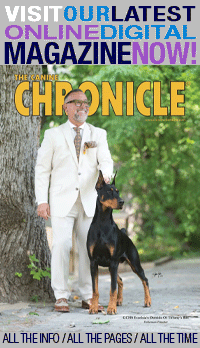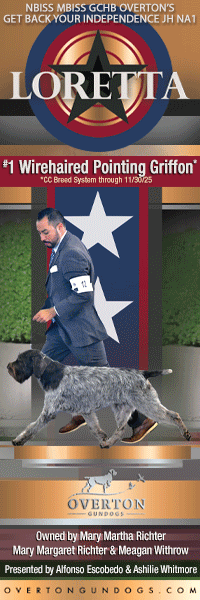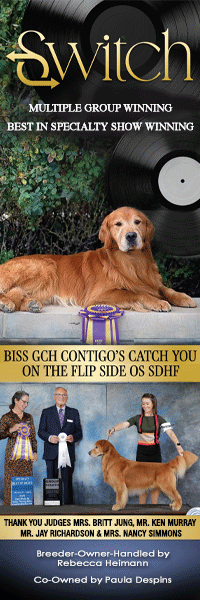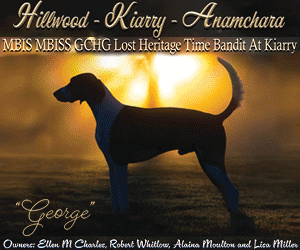Westminster Icons – John Grenville Bates

By Amy Fernandez
John Grenville Bates made history by owner-handling his Wire bitch, Ch. Pendley Calling of Blarney, to back-to-back Westminster wins in 1930 and 31.
Born in 1880, he grew up among New York’s cultured elite. He graduated from Columbia in 1903, purchased his seat on the Stock Exchange a year later, and distinguished himself in typical pursuits of his social set. However, his overriding talent was the art of the deal. Long before that phrase entered the lexicon, Bates demonstrated an ingenious ability to combine ostensibly unrelated aspects of his life for maximum advantage. He leveraged his membership in the exclusive Morris County Golf Club to secure its enviable location as the site for the Cedarhurst Kennel Club, which he founded in 1905. The club only lasted until 1909, but its shows were considered second only to Westminster. He brokered equally fabulous deals as president of the similarly short-lived Morris County Kennel Club. It’s fair to say that Bates loved dogs and dog clubs equally.
His involvement in the sport came via hunting and shooting. His kennel of Foxhounds and Gundogs at his Cedarhurst Long Island home inevitably led him to the Westminster Kennel Club, then based in nearby Babylon. He began exhibiting during his teens and registered his Blarney kennel prefix in 1906. He achieved notable success in Smooths, Welsh, Scotties, Airedales, and Irish Terriers, the breed that got him started in 1900. He finished 23 champions and was active in the breed until 1925, including a stint as ITCA president. During those years he also served as an AKC delegate and a board member. He joined the American Fox Terrier Club in 1911, but didn’t focus on the breed until 1920 when he began adding top British stock to his kennel.
Blarney kennel occupied 100 prime acres in Morristown N.J. Along with the usual luxuries, it featured one of the east coast’s first heated indoor training facilities. Known as “the cottage” Bates frequently invited close friends to join him for private dog shows to train puppies and evaluate imports.
He loved private clubs, none moreso than Westminster. He joined in 1925, became Treasurer in 1927, and VP in 1930. His social and organizational talents were ideal for the stressful, thankless job of managing the bench show committee. Within a year, the dog world agreed. In 1929, he convinced Westminster’s sponsor, Spratts, to implement an obvious, but costly measure that instantly resolved a perennial problem; replacing benching partitions with enclosed cages prevented runaway dogs, fights, and biting incidents that had become an inevitable aspect of prolonged benching in limited space.
During that time, Bates imported the two-year-old English Champion Pendley Calling of Blarney. The weekend before Westminster 1930 she took Breed at the AFTC specialty under Stanley Halle. As VP and Show Chairman, Bates had other Westminster obligations but rules then prohibited club members from exhibiting. He preferred handling his own dogs. So, when BIS rolled around he found himself in the awkward position of delegating his customary stewarding responsibility to show his dog. English Terrier authority Walter Glynn had no trouble making his decision that night.
It’s now customary to retire Westminster winners, but back then they often returned to defend their titles. No one had managed it since 1920 when Ch. Conejo Wycollar Boy repeated his 1917 triumph. When Ch. Pendley Calling of Blarney got the nod in 1931 the crowd didn’t quite see it as history in the making. They could not overlook undeniable political connotations of Westminster’s VP and Show Chairman entering and winning twice in a row. Bates was a genius at business and social interplay, but this time he may have overstepped the line. Although many encouraged him to go for the record, she was retired for breeding. Bates resigned as chairman of the bench show committee to become Westminster’s President.
Time’s February 22 coverage of the 1932 show obliquely alluded to public sentiment about the situation saying, “The annual Westminster Kennel Club show was slightly smaller than usual. Notable for his absence was Pendley Calling of Blarney, twice judged best dog in the show, whose owner, John G. Bates, chairman of the Bench Committee, kept her retired to give other terrier fanciers a chance.”
Breed historian Frank Skelly offered a more tactful assessment of Bates in his 1961 book, emphasizing the “ substantial and beneficial influence of the earlier group of importers. Often they were also breeders, but their deeper interest seemed to line more in the sporting competition of the show ring as owners of winning dogs. They were keen terrier men with an eye for a good one and a financial readiness to back their conclusions.”
Bates continued to show sparingly, but his taste for good dogs and the social aspects of the game were easily transitioned to judging. He was part of Westminster’s four judge BIS panel that selected Ch. Pinegrade Perfection back in 1927. In 1938, at age 57, he had his solo moment in the spotlight. His choice of the English Setter puppy, Daro of Maridor, made Westminster’s 62nd show another historical milestone.
At Westminster’s request, he took over managing the 1943 and 1944 shows. Wartime shortages posed unprecedented challenges, but he worked his magic and created unforgettable events even though the 1944 show went on without him. He died Feb 2, 1944. The Gazette said, “One of the most popular figures in the world of purebred dogs, John G. Bates, died just prior to the 68th Westminster that marked one of his greatest organizational achievements…He played a part in almost every sphere of activity in which purebred dogs are engaged.” Many facets of the sport benefited from his managerial talent, but his son, John Grenville Bates, Jr. may have raised the bar for successful mergers when his 1928 marriage to Victoria Frelinghuysen united two of the dog world’s most influential families.

Short URL: http://caninechronicle.com/?p=38974
Comments are closed











